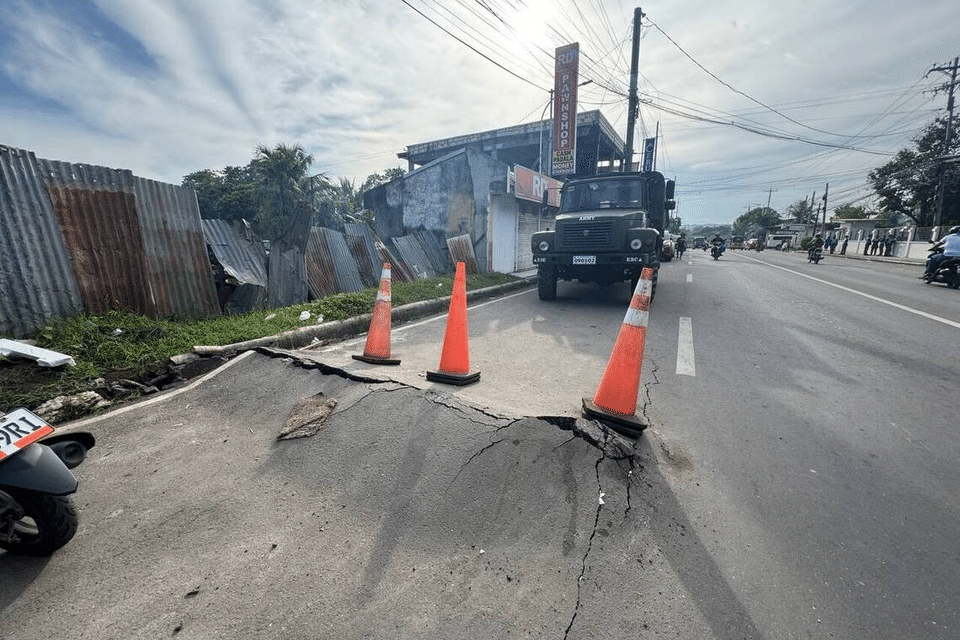October 3, 2025
BOGO CITY – Death came with a loud rumble in the pitch-dark night, as a powerful earthquake shattered the quiet of northern Cebu in the central Philippines late on Sept 30.
As at 9am on Oct 2, at least 72 people have been confirmed dead following one of the country’s deadliest natural disasters in recent years, with nearly 300 injured and more than 170,000 affected across the province.
In the aftermath, Bogo City, where nearly half of the recorded fatalities occurred, has emerged as the hardest-hit area.
The tremor, which struck shortly after 11pm on Sept 30, has reduced several buildings, churches and houses to rubble, with residents now sleeping in makeshift shelters or under tarpaulins amid continuing aftershocks.
Philippine President Ferdinand Marcos Jr arrived in Bogo City on Oct 2 to inspect the damage and meet local officials and survivors.
He announced that the Office of the President is transmitting more than 220 million pesos (S$4.9 million) worth of funds to disaster-stricken cities and towns in Cebu to help local officials with rehabilitation efforts.
He also said that a “tent city” would be put up in the coming days to temporarily shelter displaced families, with each tent equipped with enough supplies and its own power generator. He said many evacuees still prefer staying outside because of the aftershocks.
“They prefer to stay outside for now, so we’ll follow their wishes,” he said. “We’ll make sure all their basic needs are met.”
In times of disaster, affected residents are usually brought by the government to schools or evacuation centres. But Mr Marcos said it was difficult to do so in Cebu, as the earthquake was classified by state seismologists as “shallow”, which tends to cause widespread structural damage.
The government has since declared a state of calamity across Cebu’s northern corridor, allowing for the rapid release of emergency funds and the imposition of price controls on essential goods.

Bogo City, where nearly half of the recorded fatalities occurred, has emerged as the hardest-hit area. PHOTO: THE STRAITS TIMES
In the upland village of Binabag, a single family lost 10 members when a sudden landslide buried their wooden homes at the foot of a hill. The youngest was just 10 months old, asleep in bed, when rocks and mud came crashing through the roof.
Binabag resident Janessa Dignos, 37, said she felt helpless as she waited for rescuers to retrieve the bodies of her twin sister Janice and the latter’s husband and two sons, who were 11 and eight.
“I didn’t even get to say goodbye to her. The last time we spoke, we were just planning for her husband’s doctor’s appointment,” Ms Dignos told The Straits Times. “Now she’s gone”.
She said the rest of her family members have not fully grasped that they have lost 10 of their loved ones in the blink of an eye.
“We’re still processing what happened. We have to be careful because we don’t want to upset our elderly father even more as he has a heart condition,” said Ms Dignos.
Survivors, still in shock, are now appealing directly to Mr Marcos for help in rebuilding their lives.
“Mr President, we don’t want to return to that dangerous place any more. But we don’t have money left,” said Binabag resident Esperidion Lambojon in a message for Mr Marcos as he spoke to ST, tears streaming down his face as he stood in front of the white coffins of his relatives.
“We need new homes because the earthquake wiped out our entire village,” he added.
The President said 10,000 pesos will be given to every displaced family as initial assistance as the government works to help them in the months ahead.
At Cebu Provincial Hospital in Bogo, patients were initially being treated in tents erected in the carpark after the quake rendered parts of the main building structurally unsafe. But government engineers finally cleared the hospital as safe for use again in the afternoon of Oct 2.
As at Oct 1, patients requiring more complex medical procedures have been transferred to larger hospitals in nearby cities.
Dr Zoraida Yurango, the 55-year-old hospital chief, hopes the national government will provide them with running water and other much-needed medical supplies before these run out.
She is also hoping for stress debriefing to be provided, not just for the patients but also for the hospital staff who are quake victims too.
“In the first hour, so many of the patients were just staring into space. You’d really pity them. It’s the same for the staff. We’re just holding ourselves up,” she said.
The President has ordered all relevant agencies to expedite support for local communities.
“I would like to assure everybody – and this is just for the basics for now – we will not be running out of supplies of food and water for the victims,” Mr Marcos said. “This ongoing recovery programme will continue until we are satisfied that all of those affected have been provided with their needs.”
The Cebu quake was likely triggered by a fault that had not produced a powerful tremor in the past 400 years, said Mr Winchelle Sevilla, chief of the seismology division of the Philippine Institute of Volcanology and Seismology, in an Oct 1 press briefing.
The Philippines is also located in the Pacific “Ring of Fire”, where volcanic activity and earthquakes are common. The country experienced two major earthquakes in January 2025, but no fatalities were recorded.

